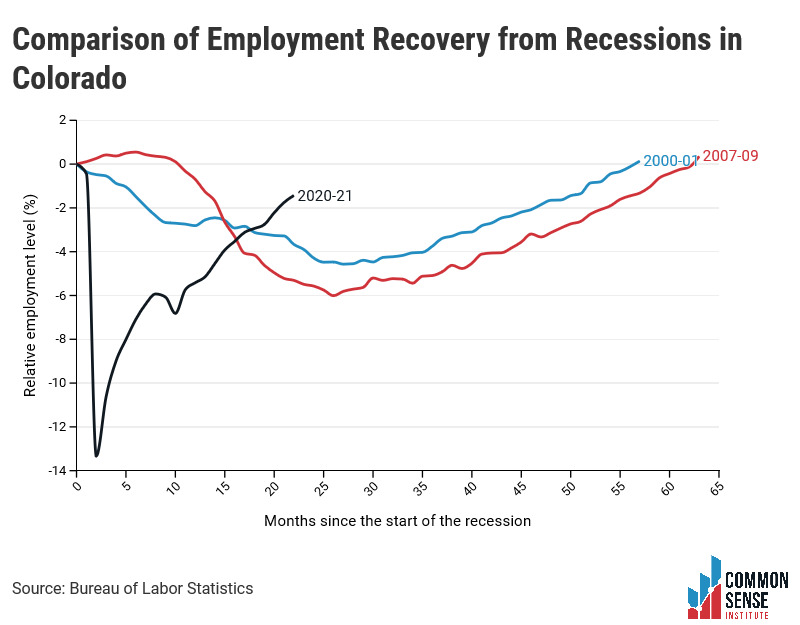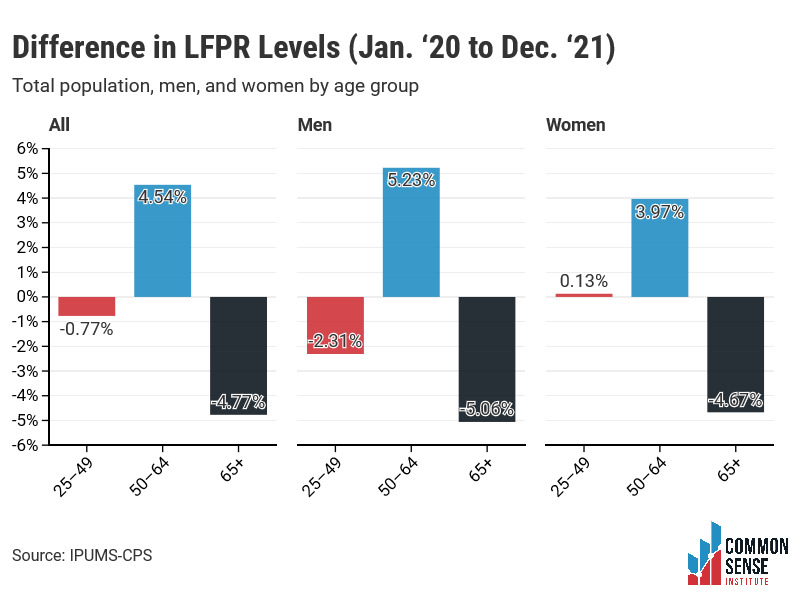Colorado added 9,000 jobs in December and November jobs were revised upwards by 5,000. The combined growth over the last two months of 2021 of 23,100 jobs presents a stark contrast to the prior year, when the two months combined for 25,500 job losses.
Key Findings—Colorado December 2021 Employment Data (BLS CES Survey[1])
- Colorado added 9,000 total nonfarm jobs in December.
- At this pace, the state would reach pre-pandemic employment levels in April 2022.
- To recover to pre-pandemic employment levels by January 2023—after adjusting for population growth—Colorado needs to add 8,636 jobs each month, on average.
- Total employment levels are down 1.45% (40,800 jobs) relative to pre-pandemic levels, ranking Colorado 14th in terms of December ‘21 job levels relative to Jan. ’20.
- New York ranked 50th and Hawaii 51st in terms of current job levels relative to Jan. ’20 and are down 7.4% and 12.4%, respectively.
- Utah, Idaho, Texas, and Arizona are the only states that have employment levels above the start of the pandemic. Utah has the highest differential (+61,300 jobs).
A Deeper Dive into Colorado Industries
- Some sectors in Colorado added jobs in December, and others lost
- The professional and business services industry added 1,900 jobs.
- The wholesale trade industry lost 400 jobs.
- Though the leisure and hospitality industry has led the recovery by adding 65,600 jobs between Jan. ‘21 and December ‘21, it is still down 16,700 jobs relative to Jan. ‘20.
- Arts, entertainment, and recreation is down 5.41% (3,200 jobs).
- Accommodation and food services is down 4.69% (13,500 jobs).
 Colorado Labor Force Update
Colorado Labor Force Update
Even with a slight increase in the state’s LFPR, the strong job growth of the end of 2021 contributed to the decline in the unemployment rate to 4.8%. The LFPR of retirement-age workers remains nearly 5 percentage points lower than pre-pandemic levels.
Key Findings—Colorado December ‘21 Labor Force Data (FRED[2], and IPUMS-CPS[3])
- December’s LFPR increased slightly to 68.3%, .5 percentage points below Jan. ’20’s LFPR of 68.8%.
- December’s unemployment rate dropped by .3 percentage points to 4.8%, which is still 2.1 percentage points above Jan. ’20’s unemployment rate of 2.7%.
- In December, the LFPR of Colorado women decreased from 63.39% to 62.79%. It is now 1.35 percentage points below its pre-pandemic level.
- The national female LFPR increased by .3 percentage points to 56.5%, which is 1.3% lower than its pre-pandemic level.
- If Colorado’s December LFPR of women was the same as it was before the pandemic, there would be 31,916 more women in the workforce today.
Prime-age, Older, and Retirement-age People in the Labor Force
- Since Jan. ’20, labor force participation rates of all 50–64-year-old workers, regardless of sex, have increased.
- Retirement-age workers have been relatively unwilling to return to the labor force; this preference is especially pronounced among women and possibly attributable to the risk of severe COVID-19 infection. There are 3,695 fewer retirement-age workers in the labor force today than there would be at the pre-pandemic participation rate.
- Of the three age groups, that of people aged 50–64 exhibits the highest LFPR increase since before the pandemic. Prime-age workers, conversely, participate at rates lower than they were in Jan. ’20, except for women aged 25-49.

[1] https://data.bls.gov/cgi-bin/dsrv?sm
[2] https://fred.stlouisfed.org/
[3] https://cps.ipums.org/cps/

